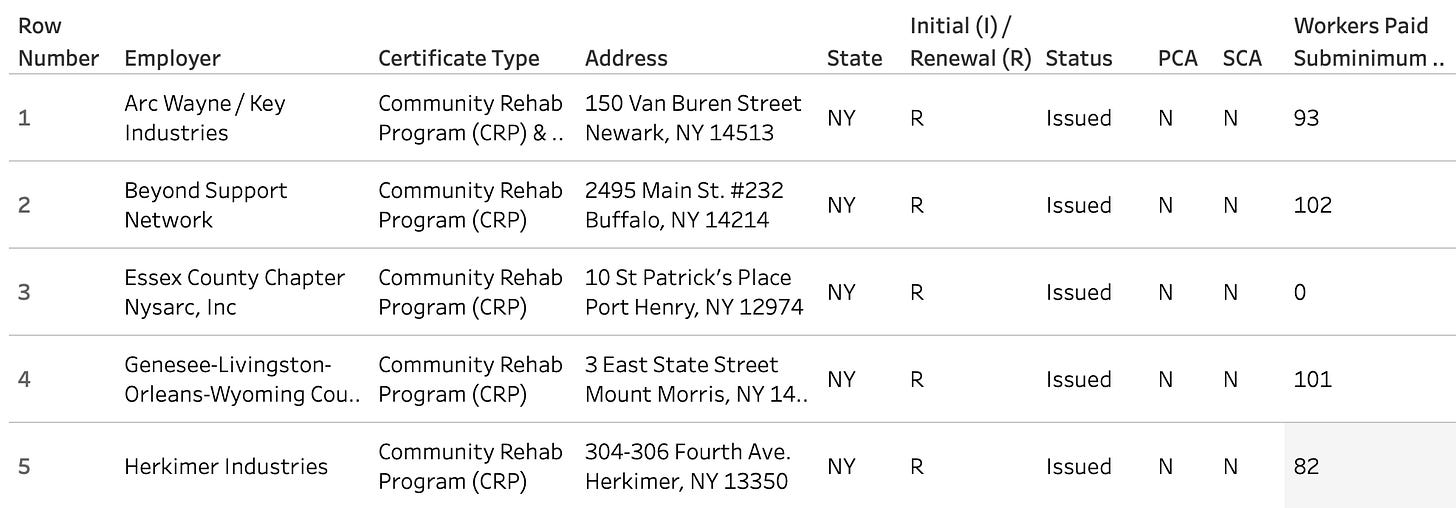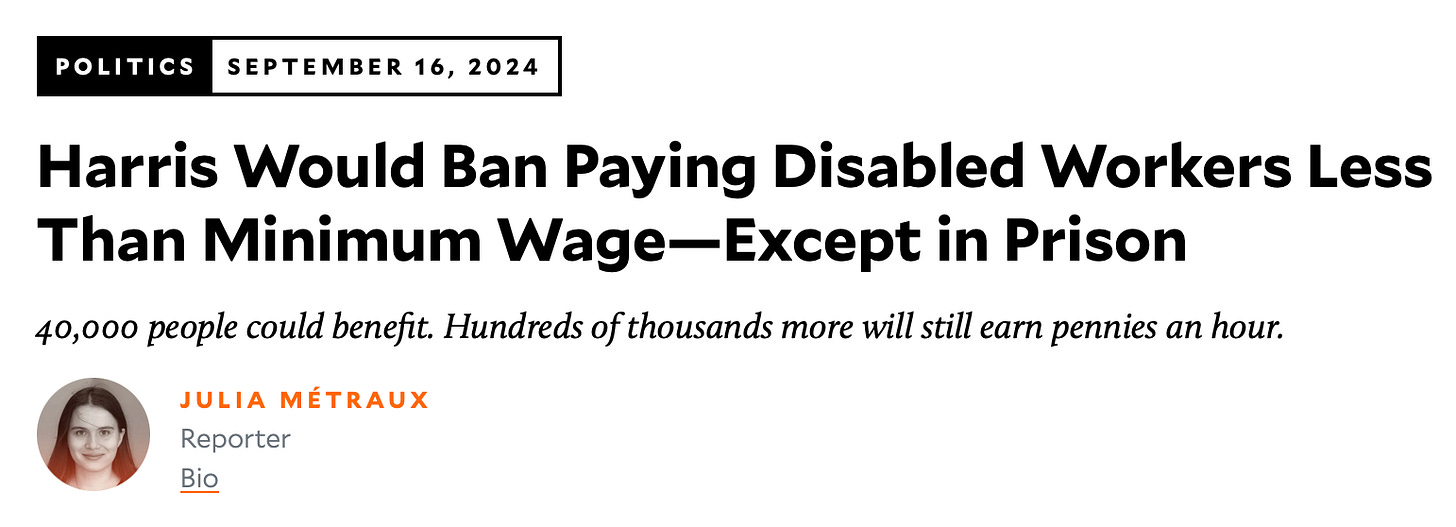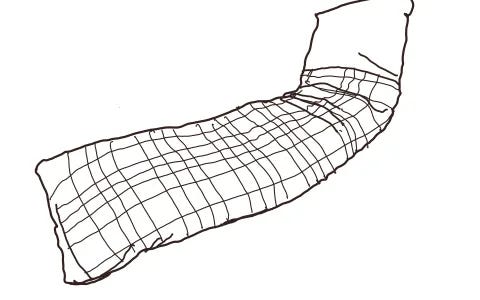Crip News v.207
Disability & Work: Pennies for Pay, new works, other news, calls, and events.
Disability & Work
This October is the 80th annual National Disability Employment Awareness Month (NDEAM) in the US. To offer some perspective that ‘awareness’ might miss, each issue this month features a section on work, income, and disability. For the previous posts, check out “What It Costs to Have a Job,” “Sick and Tired” and “Big Picture: Does Work…Work?”
Pennies for Pay
This series has focused on important but sometimes overlooked topics that can put disability employment into perspective. The anti-capitalist imperatives of disability justice. Who gets trust and who gets suspicion when disability shows up at work. The role of public benefits eligibility on joblessness.
For today’s final installment, we’re looking at subminimum wages for disabled workers.
The Endurance of 14(c)
In the bill that first mandated a federal minimum wage and overtime pay - the Fair Labor Standards Act of 1938 - there was a carve-out in Section 14(c) that lets companies pay disabled workers less than minimum wage if they get a certain certificate.

Data from May 2024 show 801 employers have these certificates. A majority of their 40,579 disabled workers were paid less thsn $3.50. And that number of workers is actually a huge reduction: in 2001, before policies like “Competitive Integrated Employment,” there were an estimated 424,000 disabled workers receiving subminimum wages.
Before Biden left office, his Department of Labor announced plans to end the program. 8 months later, the Trump administration withdrew those plans and 14(c) stands.
Sidelined Solidarities
For decades, subminimum wages have created segregated workplaces called ‘sheltered workshops.’ In the shadows of ‘employment,’ like the shadows of ‘treatment,’ there’s a long history of shutting disabled people off from public life.
As organizers Ericka A. Dixon and Sebastian Margaret explained in a recent video from the Disability Project at the Transgender Law Center, subminimum wages are legal in US prisons too.
Even though some elected and public officials voice their opposition, including Kamala Harris in her 2024 presidential campaign, they often ignore the way subminimum wages are part of shared tactics across institutions of enclosure and incarceration.
As a result, solidarity across movement organizing often begins with political education necessary to surface and explain these kinds of connections. Subminimum wages are a good example of how campaigns about ‘disability employment’ often lack a political analysis that could make these efforts actionable and energizing.
And that’s really why I wanted to publish this series over the last 4 weeks: to extend and reframe a focus on what might seem specific or nonpolitical or irrelevant. And it’s really what all of Crip News is all about: trying to use what disability reveals in order to find all the news buried in the news.
I’d love your thoughts on this series and ideas or requests for the next one. You can leave a comment on the issues or reply directly to this email.
NEWS
New Works
The UK disabled-led theatre company Vital Xposure recently published new research from its Decolonizing Disabilty Lab. Interviews reveal artists often feel forced to fragment their identities in the disability arts sector with structural inequities and missing cultural nuance.
As part of a residency at Centro de Creación Contemporánea, Matadero (Madrid), scholar Costa Badia is developing The Cripple Gallery: A Manual of Lame Instructions, “a physical and conceptual space in which to experiment with critical pedagogies, accessibility and collective organisation.”
Researcher, designer, and educator Jordan Whitewood-Neal published “Where Do We Cease to Be Citizens?” with “reflections on colonial utopian visions and crip forms of statehood and pedagogy,” in The Avery Review.
Disability Arts History Australia is the country’s first dedicated national archive of Disability Arts, created with over 100 artists, arts workers and allies. The digital resource presents over 1,600 records and 49 artist interviews.
In Other News…
Kenyan lawyers recently published an explainer on the country’s new Persons with Disabilities Act.
A site called WalletHub recently ranked the 180 most populated US cities across “33 key indicators of disability-friendliness.” Minneapolis, St. Louis, and Scottsdale ranked the highest.
CALLS
People’s CDC is calling for public comments to tell the Occupational Health and Safety Administration (OSHA) that healthcare facilities must report COVID exposures and infections. Submit by Nov. 1.
Vanessa Hernández Cruz and the LA Spoonie Collective are seeking QTBIPOC disabled artists and facilitators to lead workshops as part of a Disability Justice in Arts Initiative.
EVENTS
Ableism & Democracy: The Intersection of Issues Impacting Black People with Disabilities
Tuesday, Oct. 28, 1pm ET, on Zoom
Today, the struggle continues: Black unemployment is rising, nearly 300,000 Black women have been pushed out of the labor force this year, and federal job cuts are dismantling hard-won economic footholds. These aren’t isolated numbers — they are part of a long story of racism and ableism deciding who gets access to stability and power. In this session, we’ll honor the lessons of our past, break down the urgent economic challenges facing Black disabled communities today, and push forward a vision for a democracy that invests in us. This is not just analysis — it’s a call to action to build the future our ancestors dreamed of and our people deserve. Featuring Eric Harris, Keris Jän Myrick, Tameka Citchen-Spruce, Keri Gray, Ms. Monica Wiley, and moderated by Taryn Mackenzie Williams.Permission, Pleasure, and Power: Consent as the Foundation for Disability and Reproductive Justice
Tuesday, Oct. 28, 5:30pm ET, in-person at Brandeis University (Waltham, MA) and on Zoom
Join the Lurie Institute for Disability Policy at Brandeis University for the 3rd Annual Carrie Buck Distinguished Fellowship Keynote event featuring Distinguished Fellow, Laura Millar, and Rebecca Cokley of the Ford Foundation.





